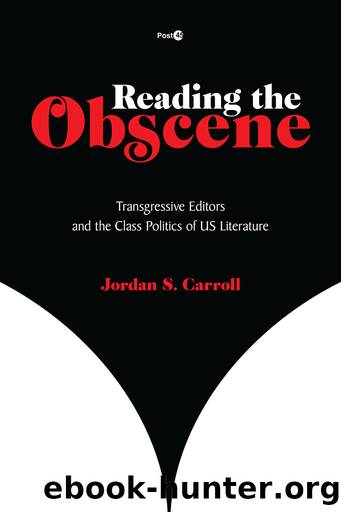Reading the Obscene by Jordan Carroll;

Author:Jordan Carroll;
Language: eng
Format: epub
Publisher: Stanford University Press
Published: 2021-06-15T00:00:00+00:00
5
Mad Ones, Mad Men
âGINSBERG WORE KHAKIS,â according to a Gap print advertisement from 1994. In the captioned photograph, the Beat poet sits on the ground wearing a rumpled suit jacket and a sloppy necktie, his khakied legs bent into a meditation position. Although his hands, resting on his lap, come together to form a mudra, his face seems more smirking than serene. Behind him we see a Buddhist shrine. Beside him sits his own camera. Ginsberg seems self-consciously staged: his foot slips off the seat cushion because he has been angled toward the photographer. We are being offered a glimpse into his private life, maybe, but everything here is for show. The rest of the advertisement looks like every other entry in the campaignâthe celebrity shot, the Gap logo, and a single terse slogan, all in monochromeâexcept for the fact that, over to the left of the image, we read, âAll fees for Mr. Ginsbergâs image are donations to Jack Kerouacâs School of Poetics, The Naropa Institute, Boulder, CO.â
This image joined a spate of Beat-themed advertisements: Jack Kerouac appeared posthumously in the same campaign in 1993, and William S. Burroughs bounced between looping video monitors in a 1994 Nike television spot. While Kerouac was helpless to withhold his product endorsement, and Burroughs seemed happy to be paid as a pitchman, Ginsberg sought to undermine his role in the advertising industry by presenting the full-page ad as an exercise in charity, devotion, and the advancement of poetry. The notice preserving Ginsbergâs opposition to crass marketing strains the eye: its white letters fade into a light gray background, legible mostly to those already in the know. As one might guess from this image, throughout his life Ginsberg maintained an uneasy and uncertain relationship with the field of advertising.
In 1951, just a few years after graduating from Columbia University, Allen Ginsberg began a career in market research and public opinion polling. He started out coding questionnaires part-time for Doherty, Clifford and Shenfield before quickly moving to National Opinion Research Center (NORC), an organization run out of the University of Chicago with an office in New York City.1 Working alongside Carl Solomon and John Clellon Holmes at NORC, Ginsberg helped gather information on Americansâ reactions to issues ranging from atomic energy to socialized medicine in order to help lawmakers, government officials, and academic researchers better understand public opinion.2 One of NORCâs central projects was an ongoing series of surveys on race relationsâthe first of its kindâwhich frequently revealed the depths of white racism, discovering that many white respondents considered Black Americans more likely to be unpatriotic and communistic.3
In an October 1960 journal entry titled âSubliminal,â Ginsberg reflects on his past career as part of a broader indictment of 1950s containment culture: âI was working in Market Research. / Who threw poison onion Germs in Korea? / Do big fat American people know their Seoul from a hole in the ground?â4 Ginsbergâs writings on this period reveal American respondents to be blind to their own interior lives as well as their nationâs imperial adventures.
Download
This site does not store any files on its server. We only index and link to content provided by other sites. Please contact the content providers to delete copyright contents if any and email us, we'll remove relevant links or contents immediately.
4 3 2 1: A Novel by Paul Auster(11078)
The handmaid's tale by Margaret Atwood(6876)
Giovanni's Room by James Baldwin(5898)
Big Magic: Creative Living Beyond Fear by Elizabeth Gilbert(4738)
Asking the Right Questions: A Guide to Critical Thinking by M. Neil Browne & Stuart M. Keeley(4603)
On Writing A Memoir of the Craft by Stephen King(4224)
Ego Is the Enemy by Ryan Holiday(4005)
Ken Follett - World without end by Ken Follett(3984)
The Body: A Guide for Occupants by Bill Bryson(3822)
Bluets by Maggie Nelson(3726)
Adulting by Kelly Williams Brown(3683)
Guilty Pleasures by Laurell K Hamilton(3602)
Eat That Frog! by Brian Tracy(3529)
White Noise - A Novel by Don DeLillo(3444)
The Poetry of Pablo Neruda by Pablo Neruda(3375)
Alive: The Story of the Andes Survivors by Piers Paul Read(3323)
The Bookshop by Penelope Fitzgerald(3239)
The Book of Joy by Dalai Lama(3239)
Fingerprints of the Gods by Graham Hancock(3226)
